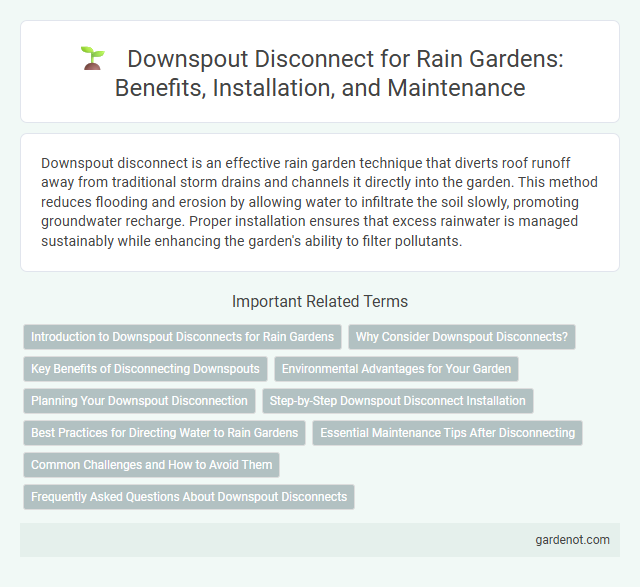Downspout disconnect is an effective rain garden technique that diverts roof runoff away from traditional storm drains and channels it directly into the garden. This method reduces flooding and erosion by allowing water to infiltrate the soil slowly, promoting groundwater recharge. Proper installation ensures that excess rainwater is managed sustainably while enhancing the garden's ability to filter pollutants.
Introduction to Downspout Disconnects for Rain Gardens
Downspout disconnects redirect roof runoff from traditional storm drains to rain gardens, enhancing stormwater management by promoting infiltration and reducing surface runoff. These systems prevent overwhelming municipal sewer systems during heavy rainfall, decreasing the risk of flooding and water pollution. Proper installation and maintenance of downspout disconnects are critical for maximizing the environmental benefits of rain gardens.
Why Consider Downspout Disconnects?
Downspout disconnects reduce stormwater runoff by diverting water away from impervious surfaces into rain gardens, promoting natural infiltration and groundwater recharge. They minimize the burden on municipal stormwater systems and reduce the risk of flooding and erosion. Implementing downspout disconnects enhances urban water management while supporting sustainable landscaping practices.
Key Benefits of Disconnecting Downspouts
Disconnecting downspouts directs roof runoff into rain gardens, significantly reducing stormwater runoff volume and minimizing local flooding risks. This practice improves groundwater recharge by allowing water to infiltrate soil naturally, enhancing urban water management efficiency. Downspout disconnection also filters pollutants before they reach waterways, protecting aquatic ecosystems and improving water quality.
Environmental Advantages for Your Garden
Downspout disconnect helps reduce stormwater runoff by diverting rainwater from hard surfaces directly into rain gardens, promoting natural infiltration and groundwater recharge. This process decreases erosion and minimizes pollutant loads entering local waterways, supporting healthier aquatic ecosystems. Implementing downspout disconnect enhances your garden's resilience to heavy rainfall while conserving water and improving soil moisture levels naturally.
Planning Your Downspout Disconnection
Planning your downspout disconnection involves assessing roof runoff volume, soil infiltration rate, and landscape slope to ensure effective rain garden performance. Selecting a suitable location away from foundations and utilities prevents water damage while maximizing infiltration. Incorporate permeable materials and contingency for overflow to manage heavy rainfall and protect your property's drainage system.
Step-by-Step Downspout Disconnect Installation
Step-by-step downspout disconnect installation begins with locating the existing downspout and marking the cut point at least 12 inches above the ground. Next, cut the downspout using a hacksaw or tin snips, remove the bottom section, and attach a flexible extension to direct water into the rain garden. Secure the extension with screws or brackets to ensure proper water flow and prevent erosion around the garden area.
Best Practices for Directing Water to Rain Gardens
Downspout disconnect is a key technique for directing roof runoff into rain gardens, effectively reducing stormwater runoff and preventing flooding. Positioning the downspout outlet at an optimal distance from the foundation and ensuring a stable, erosion-resistant splash pad or gravel trench helps protect soil and plants. Using flexible piping or channels to guide water flow while maintaining natural infiltration supports sustainable water management and garden health.
Essential Maintenance Tips After Disconnecting
Regular inspection and clearing of debris from the disconnected downspout and rain garden prevent clogging and ensure optimal water flow. Maintain the integrity of the soil by checking for erosion or settling around the garden to enhance water absorption and plant health. Seasonal pruning and mulch replenishment support rain garden vegetation and sustain its filtration efficiency.
Common Challenges and How to Avoid Them
Downspout disconnect is a vital technique in rain garden installation that redirects roof runoff away from impervious surfaces to reduce flooding and erosion. Common challenges include improper slope grading, which causes water pooling and overflow, and clogging from debris accumulation in disconnected pipes. Avoid these issues by ensuring precise grading for adequate drainage, regularly cleaning gutters and filters, and using appropriate materials designed for debris resistance.
Frequently Asked Questions About Downspout Disconnects
Downspout disconnects redirect roof runoff away from traditional sewer systems to rain gardens, enhancing stormwater management and reducing urban flooding risks. Common questions address installation techniques, maintenance requirements, and compatibility with existing gutter systems to ensure optimal water absorption and soil health. Understanding the benefits and operational specifics helps homeowners maximize rain garden efficiency while promoting sustainable landscaping practices.
Downspout disconnect Infographic

 gardenot.com
gardenot.com